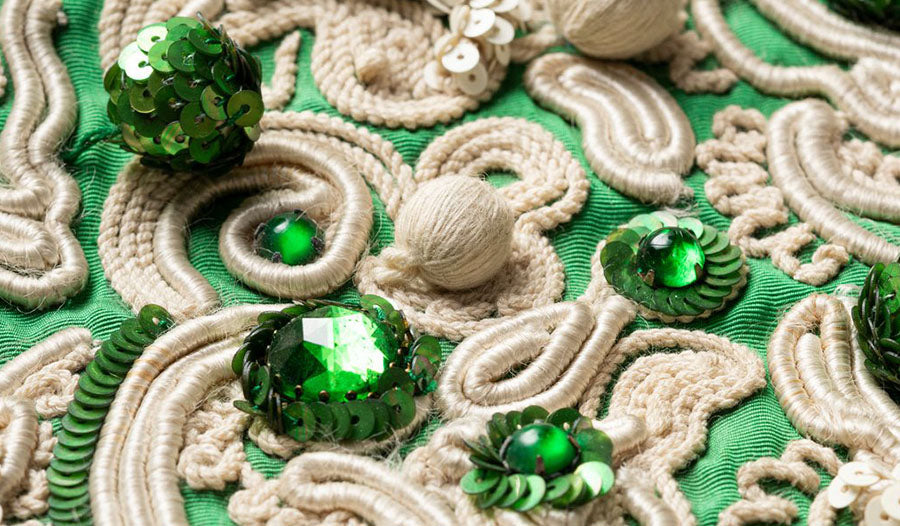
A LIFE'S WORK
 Image: Rébé for Cristobal Balenciaga, Spring Summer 1947 (detail). Soutache, sequins and cabochons create a tridimensional texture on this dress.
Image: Rébé for Cristobal Balenciaga, Spring Summer 1947 (detail). Soutache, sequins and cabochons create a tridimensional texture on this dress.
René Bégué, better know as Rébé, was born on June 26th, 1887 in Paris. His taste for the arts–especially for fine fabrics–is a passion inherited from his paternal family. In 1903, the young René started working as a deliveryman for Henri Breton, a famous lace manufacturer. He quickly climbed the ranks and became a placier, a more prestigious title than a simple salesman. Selling lace to haute couture brands opens Rébé to this very exclusive world.
In early 1904, one of Rébé’s clients, the house of Paquin, announced a competition to find and hire their new embroidery designer. In a stroke of victory, Rébé won the competition, quit his job and quickly moved to London. The English capital was a dynamic training ground for Rébé’s, who developed and adapted his personal tastes and working methods in his new home. Working for the Paquin couture house, Rébé imagined and designed all of the embellishments. This was common, in the early 20th century most fashion houses had their own embroidery workshops inhouse, and needed their own designers as well.
 Image: Rébé often used the technique of nuanced paillettes, hiding them underneath threads and other materials to add a subtle shine to his embroideries.
Image: Rébé often used the technique of nuanced paillettes, hiding them underneath threads and other materials to add a subtle shine to his embroideries.
By the end of 1906, Rébé left Paquin to return to Paris. Very satisfied with the refined and sophisticated work that Rébé did for her collections, Jeanne Beckers Paquin introduced him to Maurice Vitet, a great patron of Parisian embroidery at the time. Vitet was looking for a successor to take over his workshops, which were founded in Paris in 1894. He immediately recognized in Rébé the ideal candidate.
Rébé accepted Vitet’s proposal and began his new work at 5 rue Saint-Augustin, in the heart of Paris. In 1911, Rébé became the sole owner and commenced many years of rich collaboration. In the post-war years Rébé worked with major fashion houses. In fact, all the couturiers requested embroidery from his workshop regularly. It was the start of René Bégué’s great career as an embroiderer: working for Paquin, Worth, Philippe and Gaston, Agnès, Martial and Armand, among many others.

Image: Article is an excerpt from Nadia Albertini's new book Rébé: Broderies & Haute Couture, published by Gourcuff Gradenigo
The embroideries created by Bégué during these years show an exceptional artistic quality. The samples are quite big: half fronts of entire dresses, with each richly beaded sample measuring almost a meter long. The richness of Rébé’s collections comes from the variety of patterns, the quality and colors of the fabrics, the complexity of the techniques as well as the beauty and quality of the pearls and sequins used. The designs that Bégué offered to his customers were varied, while remaining in line with the trends of the time: geometric borders inspired by Egypt and Greece, Japanese landscapes with refined details, floral arrangements borrowed from the spirit of Art Deco, and ethnic motifs from North Africa and the Balkans often worked with metallic elements, threads or sequins.
There is a similar richness and plurality in the fabrics used as bases. With fine embroidery, the workshop most often chooses very fine silk muslin of excellent quality, almost transparent and yet ultra resistant to the weight of all these decadent materials. This fibre is easy to dye and adapts to the color ranges of pearls and sequins; the reverse (changing the embellishments to match the fabric) would be too complicated...
--
This excerpt from the article A Life's Work: René Bégué and Rébé Embroidery was written and translated by Nadia Albertini. Read the rest of the article in hte latest issue of Selvedge, Issue 103 Showstopper.
--


1 comment
Fascinating!